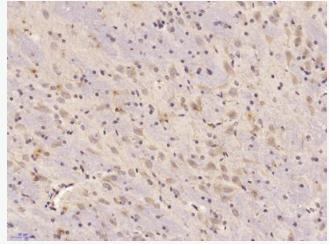Rabbit Anti-KLK7 Polyclonal Antibody
DATASHEET
Host:Rabbit
Target Protein:KLK7
IR:Immunogen Range:101/200/253
Clonality:Polyclonal
Isotype:IgG
Entrez Gene:5650
Swiss Prot:P49862
Source:KLH conjugated synthetic peptide derived from human KLK7:101/200/253
Purification:affinity purified by Protein A
Storage:0.01M TBS(pH7.4) with 1% BSA, 0.03% Proclin300 and 50% Glycerol. Shipped at 4℃. Store at -20 °C for one year. Avoid repeated freeze/thaw cycles.
Background:The human tissue Kallikrein gene family encodes 15 serine proteases. All Kallikreins share structural similarities including cysteine residues, a catalytic triad of His, Asp, and Ser residues, typically five coding exons and varied intron phases. Kallikreins are predominantly secreted as inactive zymogens prior to activation by cleavage of an N-terminal peptide and all function extracellularly. Kallikreins can be activated autocatalytically, via other Kallikreins, or additional proteases. While structurally similar, Kallikrein family members have distinct functions and have key roles in many physiological and pathological processes. Many human tissue Kallikreins also show promise as cancer biomarkers, which may facilitate earlier detection and characterization of many forms of cancer.
Kallikrein 7, also known as stratum corneum chymotryptic enzyme (SCCE) and PRSS6, is a chymotrypsin-like serine proteinase. Originally described from human skin as a serine protease involved in shedding of skin cells and remodeling if the skin, SCCE was later identified as Kallikrein 7. Kallikrein 7 is found at the highest levels in the skin, often complexed with the endogenous serpins SLPI or elafin and kallikrein 7 can be found complexed to a number of different proteinase inhibitors. In addition to skin, Kallikrein 7 has been found in the kidney, esophagus, neuronal tissues, amniotic fluid, saliva, breast milk, urine, synovial fluid, seminal plasma and serum. Kallikrein 7 has been reported to be decreased in the CSF of Alzheimer's patients and message levels of KLK7 were decreased in adenocarcinoma. In skin, overexpression of hK7 has been shown to cause a form of dermatitis and in psoriasis hK7 is expressed in higher levels than controls. The skin adhesive proteins corneodesmosin and desmocollin 1 have been reported to be substrates of Kallikrein 7, as is interleukin 1 and the insulin B-chain.
Size:50ul
Concentration:1mg/ml
Applications:ELISA(1:5000-10000)
IHC-P(1:100-500)
IHC-F(1:100-500)
IF(1:100-500)
Cross Reactive Species:Human
Mouse
Rat
Dog
Pig
Cow

僅供科研使用。不能用于人和動物治療等其它臨床診斷用!
關(guān)鍵字: KLK7;Kallikrein 7;Chymotryptic stratum;hK7;hSCCE;hSCCE;Serine protease 6;KLK7_HUMAN;
上海滬震實業(yè)有限公司是一家集研發(fā)���、生產(chǎn)和銷售于一體的生命科學實驗室產(chǎn)品生物科技企業(yè)�����。主營產(chǎn)品:試劑盒�,ELISA試劑盒,抗體���,重組蛋白��,血清�,胎牛血清���,細胞�,原代細胞 細胞培養(yǎng)試劑,常用生化試劑���。